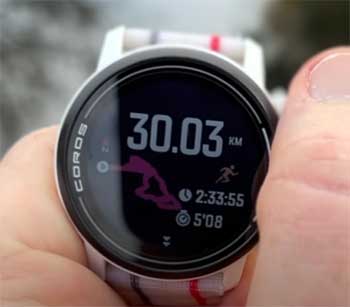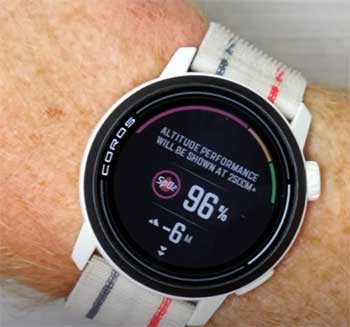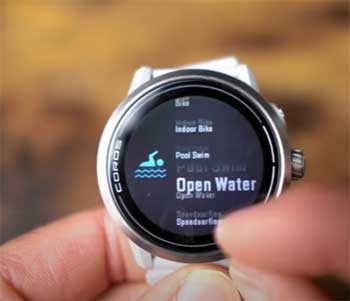I’ve been lacing up my running shoes and hitting the trails, roads, and tracks for years, always with a trusty GPS watch strapped to my wrist. When it comes to choosing the right one, I know the struggle of sifting through specs, features, and real-world performance.
That’s why I’m putting the Coros Pace 3 and Apex 2 head-to-head in this article. My goal?
To give you a clear, no-nonsense comparison of these two fantastic sports watches, breaking down their pros, cons, and key features to help you decide which one deserves a spot on your wrist.
A Brief Comparison Table
| Feature | Coros Pace 3 | Coros Apex 2 |
| Price | $229 | $349 |
| Weight (with nylon band) | 30g | 42g |
| Battery Life (Smartwatch) | 24 days | 17 days |
| Battery Life (GPS) | 38 hours | 40 hours |
| Display | 1.2″ MIP LCD, full touchscreen | 1.2″ MIP LCD, partial touchscreen |
| GPS Accuracy | Dual-frequency, All Systems On | All Systems On, no dual-frequency |
| Navigation | Breadcrumb, turn-by-turn (beta) | Offline topographic maps, turn-by-turn |
| Build Material | Polymer bezel, mineral glass | Titanium alloy bezel, sapphire glass |
| Storage | 4GB (music, routes) | 8GB (music, maps, routes) |
| Activity Profiles | Running, cycling, swimming, hiking, snow sports | Running, cycling, swimming, hiking, climbing |
| Water Resistance | 5 ATM | 5 ATM |
| Music Playback | Offline MP3 playback | Offline MP3 playback |
| Connectivity | Bluetooth, Wi-Fi | Bluetooth, Wi-Fi |
| Sensors | Optical HR, SpO2, barometer, compass | Optical HR, SpO2, barometer, compass |
My Journey With Coros Watches
As a runner who’s tackled everything from city marathons to rugged trail ultras, I’ve come to rely on GPS watches to track my performance, guide my navigation, and keep me motivated.
Over the past few months, I’ve put the Coros Pace 3 and Apex 2 through their paces—pun intended. I’ve worn them on long runs, interval sessions, and even during recovery days to monitor sleep and stress.
My experience with these watches, combined with insights from other runners and tech reviewers, forms the backbone of this comparison. Let’s break down what makes each watch tick and where they shine or stumble.
Coros Pace 3: The Lightweight Champion

The Coros Pace 3 feels like it was designed for runners who want everything without the heft.
At just 30 grams with the nylon band, it’s so light I barely notice it’s there, whether I’m sprinting through a 5K or wearing it to bed for sleep tracking.
The 1.2-inch memory-in-pixel (MIP) LCD display is crisp and readable in sunlight, and the addition of full touchscreen functionality is a game-changer for scrolling through data screens or navigating menus.
I found it especially handy during sweaty runs when fumbling with buttons isn’t ideal.
Key Features of the Pace 3
The Pace 3 packs a punch with features tailored for multi-sport athletes. Its dual-frequency GPS and All Systems On mode (connecting to GPS, GLONASS, Galileo, BeiDou, and QZSS) deliver impressive accuracy, even in tricky urban environments with tall buildings.
During a recent run through downtown Chicago, the Pace 3 tracked my route with precision, staying true to the path where my old Garmin sometimes wavered.
The new optical heart rate sensor is a step up from its predecessor, the Pace 2, and in my tests, it matched my chest strap’s readings within a few beats per minute, even during high-intensity intervals.
Battery life is another standout. The Pace 3 lasts up to 24 days in smartwatch mode and 38 hours with GPS active. I charged it once during a two-week training block and still had juice left for a weekend trail race. The watch also supports offline MP3 playback, which I tested with a playlist during a long run.
It worked smoothly with my Bluetooth headphones, though I’ll admit I usually stick to my phone for music due to safety concerns. Wi-Fi connectivity makes syncing activities faster than Bluetooth alone, which is a nice touch when you’re impatient like me.
Navigation is solid but limited to breadcrumb-style routes with turn-by-turn directions (still in beta as of early 2025). I uploaded a GPX file for a trail run, and the watch kept me on course with deviation alerts, but I missed having a full map for context.
The Pace 3 also offers advanced training metrics through Coros EvoLab, including VO2 max, training load, and running form analysis (with an optional Pod accessory). These insights helped me tweak my stride during a half-marathon training cycle, shaving a few seconds off my pace.
Pros of The Coros Pace 3
- Featherlight Design: At 30 grams, it’s one of the lightest GPS watches out there, perfect for all-day wear and sleep tracking.
- Affordable Price: At $229, it’s a steal for the features, undercutting competitors like the Garmin Forerunner 255.
- Top-Notch GPS Accuracy: Dual-frequency and All Systems On modes make it reliable in cities and remote areas.
- Long Battery Life: 24 days in smartwatch mode and 38 hours in GPS mode mean less charging hassle.
- Full Touchscreen: Smooth navigation through menus and data screens, with the option to disable it for activities.
- Wi-Fi Syncing: Faster data transfer compared to Bluetooth-only syncing.
Cons of The Coros Pace 3
- Limited Navigation: Breadcrumb navigation lacks the context of full maps, which can be frustrating on unfamiliar trails.
- No ANT+ Connectivity: If you use ANT+ accessories like bike power meters, you’re out of luck.
- Basic Smart Features: Notifications and offline music are nice, but there’s no contactless payment or third-party app support.
- Touchscreen Lag: The touchscreen is a bit sluggish compared to a smartphone, though it’s an improvement over the Pace 2.
- No AMOLED Display: The MIP LCD is great for battery life but lacks the vibrancy of newer AMOLED screens like the Pace Pro’s.
Coros Apex 2: The Rugged All-Rounder

The Coros Apex 2 feels like it was built for adventure.
With a titanium alloy bezel and sapphire glass screen, it’s more durable than the Pace 3 and looks premium on the wrist.
At 42 grams with the nylon band, it’s heavier than the Pace 3 but still comfortable for long runs and daily wear.
The 1.2-inch MIP LCD display is sharp, though it only offers partial touchscreen functionality for scrolling during workouts and navigation. I found myself relying on the single dial and button for most interactions, which took some getting used to after years of multi-button Garmins.
Key Features of The Apex 2
The Apex 2 is designed for outdoor enthusiasts, with offline topographic and landscape maps that you can download from the Coros website. During a trail run in Colorado, I loaded a map and followed a route with turn-by-turn directions, which was a lifesaver when I veered off course.
The watch doesn’t support routable maps, so it won’t replot your path if you get lost, but the deviation alerts helped me backtrack. The All Systems On GPS mode is accurate, though it lacks the dual-frequency chip found in the Pace 3, so it’s slightly less reliable in dense urban areas.
Battery life is impressive, with 17 days in smartwatch mode and 40 hours in GPS mode—slightly better than the Pace 3 for activities. I wore it for a multi-day hiking trip and didn’t need to charge it once.
The Apex 2 also supports offline MP3 playback and has 8GB of storage, double the Pace 3’s 4GB, which is handy for storing more music or maps. The watch includes a broader range of activity profiles, like rock climbing, which the Pace 3 skips, making it a better pick for multi-sport athletes.
The Apex 2’s heart rate sensor is similar to the Pace 3’s, and in my tests, it performed well during steady-state runs but occasionally lagged during rapid heart rate changes in intervals.
Like the Pace 3, it offers EvoLab metrics, sleep tracking, and stress monitoring. The rugged build makes it ideal for harsh conditions—I’ve worn it in rain, snow, and extreme heat without a hiccup.
Pros of The Coros Apex 2
- Durable Build: Titanium alloy and sapphire glass make it tough enough for trails and extreme conditions.
- Offline Maps: Topographic and landscape maps provide better navigation for outdoor adventures.
- Long GPS Battery Life: 40 hours in GPS mode is perfect for ultra-marathons and multi-day treks.
- More Storage: 8GB allows for more music, maps, and routes compared to the Pace 3’s 4GB.
- Versatile Activity Profiles: Supports climbing and other niche sports, ideal for multi-sport athletes.
- Premium Look: The titanium bezel gives it a high-end feel that stands out.
Cons of The Coros Apex 2
- Higher Price: At $349, it’s $120 more than the Pace 3, which may not justify the extra features for some.
- Heavier: 42 grams isn’t heavy, but it’s noticeably bulkier than the Pace 3’s 30 grams.
- No Dual-Frequency GPS: Less accurate in urban environments compared to the Pace 3.
- Partial Touchscreen: Limited to workouts and navigation, which can feel restrictive.
- Single Dial Navigation: Takes time to master if you’re used to multi-button watches.
- No ANT+ Connectivity: Like the Pace 3, it’s limited to Bluetooth for accessories.
Head-to-Head Comparison of Coros Pace 3 And Apex 2
Let’s get into the meat of this comparison by pitting the Pace 3 and Apex 2 against each other across key categories. I’ve tested both watches extensively, and I’ll share my real-world insights to help you decide which one aligns with your needs.
- Design and Comfort

The Pace 3 is the clear winner for comfort. Its 30-gram weight makes it feel like an extension of my wrist, whether I’m running a marathon or sleeping.
The nylon band is a dream for smaller wrists like mine—it’s adjustable and doesn’t slip during sweaty runs.
However, if you have larger wrists, the nylon band can be tricky to remove, as it doesn’t fully unbuckle.
The silicone band option is heavier at 39 grams but more versatile.
The Apex 2, at 42 grams, feels sturdier but more noticeable. The titanium bezel and sapphire glass give it a premium vibe, but it’s less ideal for all-day wear compared to the Pace 3.
The single dial and button setup is intuitive once you get the hang of it, but I missed the extra buttons I’m used to on other watches. Both watches are 5 ATM water-resistant, so they handle swimming and showers with ease.
- Battery Life
Both watches boast incredible battery life, but they cater to different needs. The Pace 3’s 24-day smartwatch mode is perfect for those who hate charging frequently.
I went nearly three weeks without plugging it in, even with daily runs and sleep tracking. Its 38-hour GPS mode is plenty for most races, though it fell short during a 50K ultra when I had to conserve battery.
The Apex 2’s 17-day smartwatch mode is slightly less impressive, but its 40-hour GPS mode edges out the Pace 3 for ultra-endurance events. I used it for a two-day hiking trip with continuous GPS, and it still had 20% battery left.
If you’re tackling multi-day adventures, the Apex 2 has the edge.
- GPS and Navigation
GPS accuracy is where the Pace 3 pulls ahead. Its dual-frequency chip and All Systems On mode make it a beast in challenging environments. During a run in New York City, it tracked my route through skyscraper canyons with minimal drift.
The breadcrumb navigation is functional but bare-bones—you get a trail trace and deviation alerts, but no map context. Turn-by-turn directions (in beta) worked well in my tests, but I occasionally got lost on complex trails.
The Apex 2’s All Systems On GPS is solid but struggles slightly in urban settings compared to the Pace 3. Its offline maps are a huge advantage for trail runners and hikers. I loaded a topographic map for a run in the Rockies, and it gave me confidence to explore new routes.
However, the lack of routable maps means you’ll need to manually backtrack if you stray. The partial touchscreen made zooming in on maps easier, but it’s not as seamless as a full touchscreen.
- Training Features

Both watches offer Coros EvoLab metrics, including VO2 max, training load, and running form analysis.
I found these insights invaluable for fine-tuning my marathon training.
The Pace 3’s running form test (with the optional Pod) helped me adjust my cadence, while the Apex 2’s broader activity profiles catered to my occasional forays into cycling and climbing.
Both support custom workouts and training plans, which I synced from the Coros app for a half-marathon prep.
The Pace 3’s Virtual Pacer feature is a standout for race day. I set a goal pace for a 10K, and the watch displayed real-time feedback without annoying beeps, keeping me calm and focused.
The Apex 2 has a similar feature, plus an Extender option that mirrors data to your phone screen, which I found useful during indoor cycling sessions.
- Smart Features
Neither watch is a full-fledged smartwatch, but they cover the basics. Both offer notifications for calls and texts, offline MP3 playback, and action camera controls for GoPro and Insta360. The Pace 3’s 4GB storage holds about 1,000 songs, while the Apex 2’s 8GB doubles that.
I loaded a playlist on both and found the music playback reliable, though the lack of Spotify integration is a bummer.
Wi-Fi syncing on both watches speeds up data transfers, but the Pace 3’s full touchscreen makes navigating menus slightly smoother. Neither supports contactless payments or third-party apps, which is a drawback compared to Garmin’s ecosystem.
If you want a watch that doubles as a lifestyle device, you might find both lacking.
- Price and Value
At $229, the Pace 3 is a bargain for its features. It’s hard to find another watch with dual-frequency GPS, long battery life, and a touchscreen at this price.
The Apex 2, at $349, feels like a premium investment, but the extra cost is only justified if you need offline maps or the rugged build. For most runners, the Pace 3 delivers 90% of the Apex 2’s functionality for $120 less.
Who Should Choose Which?
The Pace 3 is my pick for road runners, marathoners, and budget-conscious athletes. Its lightweight design, stellar GPS accuracy, and long battery life make it a no-brainer for daily training and racing.
If you mostly stick to roads or familiar trails and don’t need full maps, it’s hard to beat.
The Apex 2 is better suited for trail runners, ultramarathoners, and multi-sport adventurers. Its durable build, offline maps, and extra activity profiles make it ideal for rugged terrains and diverse activities.
If you’re tackling remote trails or multi-day events, the Apex 2’s navigation and battery life are worth the extra cost.
My Personal Take
After testing both watches, I lean toward the Pace 3 for my needs. Its featherlight feel and precise GPS tracking fit my road-running lifestyle, and the price is easier to swallow.
That said, I loved the Apex 2’s maps during trail runs, and its premium build gave me confidence in harsh conditions. Your choice depends on your priorities—budget and comfort versus durability and navigation.
Frequently Asked Questions (FAQ)
The Pace 3 is the better choice with its dual-frequency GPS, full touchscreen, and improved heart rate sensor. The Pace 2 is still a great budget option at $199 but lacks Wi-Fi and some advanced features.
The Apex 2 has a titanium bezel, sapphire glass, offline maps, and more activity profiles, making it better for trails and multi-sport use. The Pace 2 is lighter (29g vs. 42g), cheaper ($199 vs. $349), and supports ANT+ connectivity.
Yes, the Pace 3 is an excellent watch for runners and multi-sport athletes, offering dual-frequency GPS, long battery life, and advanced metrics at a budget-friendly $229.
The Pace Pro has an AMOLED display, 32GB storage, and offline maps, but costs $349 and is heavier (37g with nylon band). The Pace 3 ($229) uses an MIP LCD, has 4GB storage, and relies on breadcrumb navigation.
Wrapping Up
You’re standing at a crossroads, deciding between the Coros Pace 3 and Apex 2, and I hope this comparison has lit the way. The Pace 3 is your go-to if you want a lightweight, budget-friendly watch with killer GPS accuracy and enough features to fuel your runs.
The Apex 2 is your adventure buddy, built tough with offline maps for trails and beyond. Think about your goals—road races or rugged exploration—and pick the watch that matches your vibe.
Whichever you choose, you’re getting a solid partner to push your limits.
